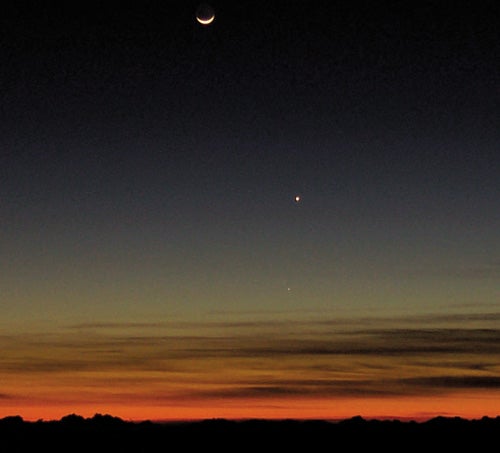If you’re the adventurous type and think you can get by without the Moon’s help, start your Mercury quest around the beginning of March. Mercury will be visible throughout the first 3 weeks of March, with optimum visibility around greatest eastern elongation March 12.
Is it true Copernicus never saw Mercury? After mentioning the Copernicus-Mercury legend in this column 2 years ago (“Mercurial sightings,” April 2003), I received a letter from noted British astronomy-writer Sir Patrick Moore. He wrote that, during a visit to Copernicus’ hometown of Torun, Poland, in 1973, he viewed Mercury on 6 consecutive evenings — even through the city’s light-polluted skies.
The inference was that Copernicus would have had little trouble spotting the planet. Unfortunately, Copernicus isn’t around to settle the question. But his writing may provide some insight.
While working on his Sun-centered model of the solar system, Copernicus attempted to calculate the planets’ orbits. This task requires observations of their positions in the night sky. By his own account, he was unable to see Mercury because of the “vapours” (fog) that enshrouded the nearby Vistula River.
Still, it’s hard to imagine this celebrated astronomer failed to see Mercury — especially during his extensive travels throughout Europe. The whole matter reminds me there’s more to astronomy than probing the night sky with a telescope. It’s also about exploring the rich and fascinating history of the oldest science.
After its encounter with Mercury, the Moon continues a steep nightly climb in the western sky. If you point a telescope moonward the evening of March 16, your gaze will be drawn to a striking row of three craters near the terminator — the border between the Moon’s dark and bright sides. All three craters are 62-65 miles (100-105 kilometers) in diameter (big enough to hold the state of Rhode Island), but that’s where the similarity ends. Theophilus, the deepest of the three (about 13,000 feet, or 4,000 meters) and most recently formed, has a pronounced central peak. The other two, Cyrillus and Catharina, are shallower and more ancient.
When viewing the Moon with a telescope, start with low magnification (25-50x) to locate your area of interest, then switch to 100x for a better view. If it’s cloudy and you can’t see the Moon, log on to the Lunar Navigator at www.lunarrepublic.com/atlas/index.shtml. You’ll find an interactive map that identifies some 2,500 lunar features.
Last year, I challenged fellow Astronomy writer Phil Harrington to a Messier marathon (March 2004). My trash-talking was for naught, as cloudy skies here in the northeast United States shut us down. Although this event (an attempt to observe as many of the 100-plus deep-space objects in the Messier Catalog as possible in a single night) can be run anytime, it’s during March that the Sun hides the fewest Messier objects. The best opportunity occurs annually around March 21, but this year, a waxing gibbous Moon will spoil things. I’m planning my Messier marathon for the moonless weekend of March 11.
Try your luck locating some of the brighter Messier objects plotted on our all-sky map on page 55.
Get your telescope ready, Phil. You’re going down!
Next month: We explore Gemini the Triplets. If you thought Gemini represented the heavenly Twins, stay tuned for a pleasant surprise! Clear skies.











